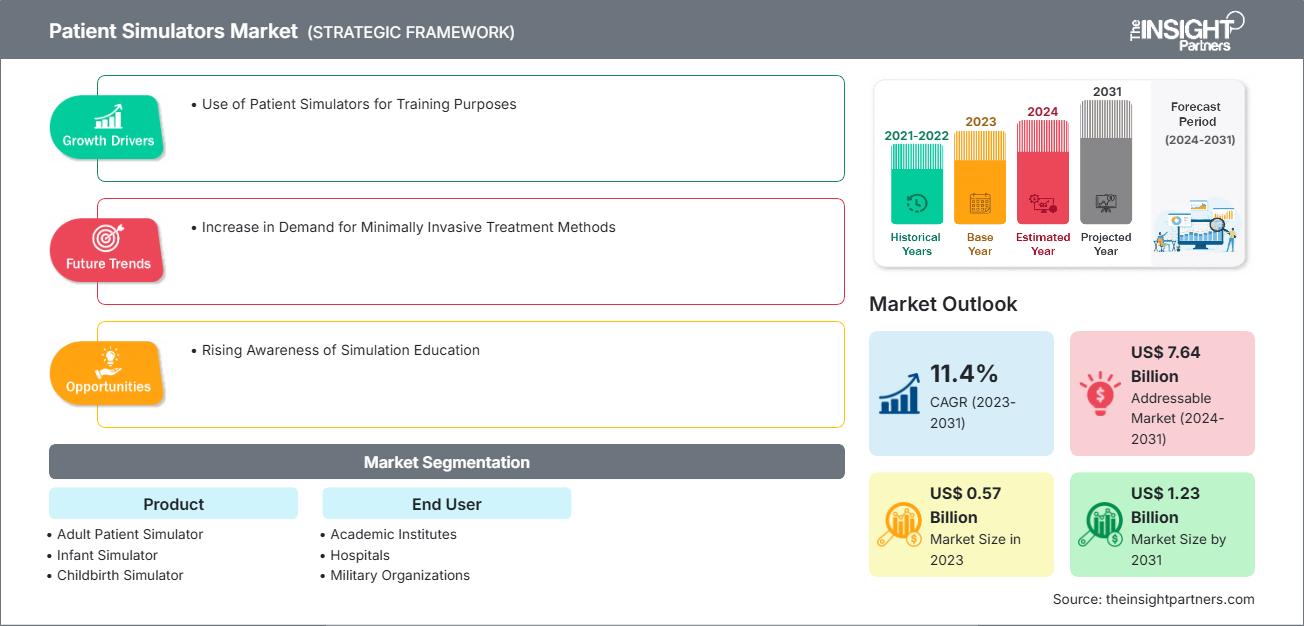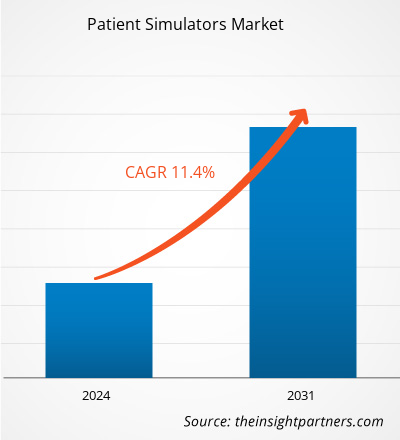Si prevede che il mercato dei simulatori di pazienti raggiungerà 1,23 miliardi di dollari entro il 2031, rispetto ai 0,57 miliardi di dollari del 2023. Si prevede che il mercato registrerà un CAGR dell'11,4% nel periodo 2023-2031. I crescenti progressi tecnologici nei simulatori di pazienti rimarranno probabilmente una tendenza chiave nel mercato.
Analisi di mercato dei simulatori di pazienti
I fattori chiave che stanno guidando la crescita del mercato sono la crescente domanda di simulatori di pazienti per la formazione del personale medico e l'aumento della domanda di metodi di trattamento minimamente invasivi. Tuttavia, si prevede che l'elevato costo dei simulatori di pazienti ostacolerà il mercato durante il periodo di previsione. Inoltre, la crescente consapevolezza della formazione basata sulla simulazione ha creato opportunità di crescita per il mercato dei simulatori di pazienti nel prossimo periodo di previsione.
Panoramica del mercato dei simulatori di pazienti
La simulazione del paziente consente a operatori sanitari e studenti di sviluppare le competenze tecniche e professionali richieste nei rispettivi campi di competenza, senza i rischi insiti nella gestione di pazienti umani. I modelli di formazione non solo consentono agli studenti di acquisire esperienza pratica, ma offrono anche un'eccellente visualizzazione. I simulatori ad alta fedeltà consentono di rilevare e visualizzare polso, respiro, ritmo cardiaco e pressione sanguigna su apparecchiature mediche reali, proprio come su pazienti reali. Queste caratteristiche coinvolgono le emozioni degli studenti e offrono un ambiente di apprendimento realistico, consentendo loro di immergersi nell'esercizio e di trattare il paziente simulato proprio come farebbero con un paziente reale. L'uso di strumenti di formazione basati sulla simulazione in chirurgia è in rapida crescita e ha mostrato modalità di formazione alternative vantaggiose che consentono di migliorare le competenze chirurgiche nonostante le pressioni sul posto di lavoro. Il ruolo principale della simulazione è quello di formare coloro che si preparano o lavorano nell'assistenza sanitaria. La formazione basata sulla simulazione può trasformare un team di esperti in un team di esperti. Pertanto, il crescente utilizzo di simulatori negli ospedali universitari, nelle scuole infermieristiche, nei centri di formazione medico militare e nei centri di formazione per paramedici a scopo formativo sta trainando il mercato dei simulatori di paziente.
Personalizza questo report in base alle tue esigenze
Riceverai la personalizzazione gratuita di qualsiasi report, incluse parti di questo report, analisi a livello nazionale, pacchetto dati Excel e potrai usufruire di fantastiche offerte e sconti per start-up e università.
Mercato dei simulatori di pazienti: approfondimenti strategici

- Scopri le principali tendenze di mercato di questo rapporto.Questo campione GRATUITO includerà analisi dei dati, che spaziano dalle tendenze di mercato alle tempi e alle previsioni.
Driver e opportunità del mercato dei simulatori di pazienti
Aumento della domanda di trattamenti minimamente invasivi
Una procedura medica mininvasiva viene generalmente eseguita inserendo il dispositivo nel corpo attraverso la pelle, una cavità corporea o un'apertura anatomica, ma con il minimo danno possibile a queste strutture. Negli ultimi anni, sono stati compiuti notevoli progressi nel trattamento delle malattie cardiovascolari. Tuttavia, queste complesse procedure mediche richiedono una vasta esperienza e competenza tecnica. Il trattamento complesso delle malattie cardiovascolari è reso più confortevole con l'ausilio di simulatori. Il sistema può produrre modelli vascolari 3D realistici segmentati a partire da set di dati dei pazienti, che includono un cuore pulsante, e fornire un modulo di calcolo della forza e di feedback della forza in tempo reale per i simulatori di pazienti. Inoltre, la chirurgia mininvasiva avanzata (MIS), ovvero la chirurgia assistita da robot, sta ottenendo sempre più successo. Vi è una crescente necessità di formare specializzandi in questo tipo di intervento chirurgico. La crescente domanda di MIS sta stimolando la crescita del mercato dei simulatori di pazienti.
Crescente consapevolezza dell'educazione alla simulazione
Diverse organizzazioni svolgono diverse attività di sensibilizzazione sulla simulazione dei pazienti. Ad esempio, nel 2007 è stata fondata la Latin American Society for Simulation in Healthcare (ALASIC) con l'idea di creare collaborazione e networking all'interno del continente tra membri provenienti da diversi paesi del Nord, Centro e Sud America. Considerata l'importanza della sicurezza dei pazienti, anche molte università stanno aprendo centri di simulazione dei pazienti. Centri di simulazione sanitaria vengono costantemente inaugurati negli Stati Uniti e in tutto il mondo.
I centri di simulazione dispongono di medici specializzati, manichini avanzati e computerizzati di tutte le età e condizioni simulate per aiutare studenti e operatori sanitari a mettere in pratica le competenze cliniche. Questi centri di formazione forniranno inoltre supporto per le competenze comunicative e decisionali e forniranno formazione pratica su diagnosi, trattamento e assistenza medica. Si stima che forniranno oltre 50.000 ore di apprendimento pratico a quasi 20.000 studenti che lavorano o intraprendono una carriera nelle scienze della salute. Pertanto, si prevede che la crescente consapevolezza della formazione basata sulla simulazione offrirà un'opportunità per il mercato della simulazione dei pazienti.
Analisi della segmentazione del rapporto di mercato dei simulatori di pazienti
I segmenti chiave che hanno contribuito alla derivazione dell'analisi di mercato dei simulatori di pazienti sono il prodotto e l'utente finale.
- In base al prodotto, il mercato dei simulatori di paziente è segmentato in simulatori di paziente adulto, simulatori di neonato e simulatori di parto. Il segmento dei simulatori di paziente adulto ha detenuto una quota di mercato maggiore nel 2023.
- In base all'utente finale, il mercato dei simulatori di paziente è segmentato in istituti accademici, ospedali e organizzazioni militari. Il segmento degli istituti accademici deteneva una quota di mercato maggiore nel 2023.
Analisi della quota di mercato dei simulatori di pazienti per area geografica
L'ambito geografico del rapporto di mercato sui simulatori di pazienti è suddiviso principalmente in cinque regioni: Nord America, Asia Pacifico, Europa, Medio Oriente e Africa e Sud e Centro America.
In Nord America, gli Stati Uniti rappresentano il mercato più grande per i simulatori di pazienti. I simulatori di pazienti sono stati utilizzati da numerosi produttori e istituti di formazione per fornire formazione. Ad esempio, il Johns Hopkins Medicine Simulation Center è un moderno centro di formazione medica completamente accreditato che utilizza una varietà di tecniche di simulazione, come la simulazione computerizzata, la realtà virtuale, i simulatori di attività, la simulazione di pazienti umani e pazienti e docenti standardizzati. Migliorare la sicurezza dell'assistenza ai pazienti è l'obiettivo principale del centro. Queste strutture di formazione migliorano il livello di comfort del medico e la sua capacità di rispondere a un'emergenza, oltre a contribuire a migliorare la sicurezza dei pazienti.
Si prevede che le statistiche sopra menzionate sui decessi causati da errori medici, insieme alle misure per includere l'uso di simulatori di pazienti a fini di formazione, stimoleranno la domanda di simulatori di pazienti negli Stati Uniti durante il periodo di previsione a un ritmo significativo.
Approfondimenti regionali sul mercato dei simulatori di pazienti
Le tendenze e i fattori regionali che hanno influenzato il mercato dei simulatori di paziente durante il periodo di previsione sono stati ampiamente spiegati dagli analisti di The Insight Partners. Questa sezione illustra anche i segmenti e la distribuzione geografica del mercato dei simulatori di paziente in Nord America, Europa, Asia-Pacifico, Medio Oriente e Africa, America Meridionale e Centrale.
Ambito del rapporto di mercato sui simulatori di pazienti
| Attributo del report | Dettagli |
|---|---|
| Dimensioni del mercato nel 2023 | 0,57 miliardi di dollari USA |
| Dimensioni del mercato entro il 2031 | 1,23 miliardi di dollari USA |
| CAGR globale (2023 - 2031) | 11,4% |
| Dati storici | 2021-2022 |
| Periodo di previsione | 2024-2031 |
| Segmenti coperti | Per prodotto
|
| Regioni e paesi coperti | America del Nord
|
| Leader di mercato e profili aziendali chiave |
|
Densità degli operatori del mercato dei simulatori di pazienti: comprendere il suo impatto sulle dinamiche aziendali
Il mercato dei simulatori di paziente è in rapida crescita, trainato dalla crescente domanda degli utenti finali, dovuta a fattori quali l'evoluzione delle preferenze dei consumatori, i progressi tecnologici e una maggiore consapevolezza dei vantaggi del prodotto. Con l'aumento della domanda, le aziende stanno ampliando la propria offerta, innovando per soddisfare le esigenze dei consumatori e sfruttando le tendenze emergenti, alimentando ulteriormente la crescita del mercato.

- Ottieni una panoramica dei principali attori del mercato dei simulatori di pazienti
Notizie di mercato e sviluppi recenti sui simulatori di pazienti
Il mercato dei simulatori di pazienti viene valutato raccogliendo dati qualitativi e quantitativi a seguito di ricerche primarie e secondarie, che includono importanti pubblicazioni aziendali, dati di associazioni e database. Di seguito sono elencati alcuni degli sviluppi nel mercato dei simulatori di pazienti:
- GigXR Inc. e CAE Healthcare hanno stretto una partnership per migliorare l'efficienza e l'efficacia della simulazione clinica. La collaborazione tra GigXR e CAE Healthcare semplifica l'implementazione e la gestione della simulazione multimodale per scuole di medicina, scuole infermieristiche, sistemi ospedalieri, operatori di primo soccorso e pubblica amministrazione, abbracciando modalità analogiche, immersive e digitali che possono essere utilizzate per creare programmi di studio completi. (Fonte: CAE Healthcare, sito web aziendale, gennaio 2024)
- Laerdal Medical e SimX collaborano per ampliare l'impatto della formazione basata sulla simulazione medica in realtà virtuale. Grazie a questa partnership, Laerdal diventerà il distributore principale della piattaforma di simulazione in realtà virtuale SimX per ospedali, servizi di emergenza medica e clienti governativi negli Stati Uniti e in Canada. (Fonte: Laerdal Medical, sito web aziendale, giugno 2022)
Copertura e risultati del rapporto sul mercato dei simulatori di pazienti
Il rapporto "Dimensioni e previsioni del mercato dei simulatori di pazienti (2021-2031)" fornisce un'analisi dettagliata del mercato che copre le seguenti aree:
- dimensioni e previsioni del mercato dei simulatori di pazienti a livello globale, regionale e nazionale per tutti i segmenti di mercato chiave trattati dall'ambito
- tendenze del mercato dei simulatori di pazienti e dinamiche di mercato come conducenti, sistemi di ritenuta e opportunità chiave
- Analisi dettagliata delle cinque forze PEST/Porter e SWOT
- Analisi di mercato dei simulatori di pazienti che copre le principali tendenze del mercato, il quadro globale e regionale, i principali attori, le normative ei recenti sviluppi del mercato.
- Analisi del panorama industriale e della concorrenza che copre la concentrazione del mercato, l'analisi della mappa termica, i principali attori e gli sviluppi recenti per il mercato dei simulatori di pazienti
- Profili aziendali dettagliati
- Analisi storica (2 anni), anno base, previsione (7 anni) con CAGR
- Analisi PEST e SWOT
- Valore/volume delle dimensioni del mercato - Globale, Regionale, Nazionale
- Industria e panorama competitivo
- Set di dati Excel
Report recenti
Testimonianze
Motivo dell'acquisto
- Processo decisionale informato
- Comprensione delle dinamiche di mercato
- Analisi competitiva
- Analisi dei clienti
- Previsioni di mercato
- Mitigazione del rischio
- Pianificazione strategica
- Giustificazione degli investimenti
- Identificazione dei mercati emergenti
- Miglioramento delle strategie di marketing
- Aumento dell'efficienza operativa
- Allineamento alle tendenze normative




















 Ottieni un campione gratuito per - Mercato dei simulatori di pazienti
Ottieni un campione gratuito per - Mercato dei simulatori di pazienti